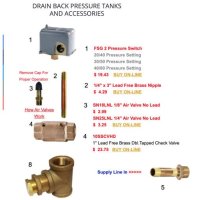Hello All,
I have deep well / drain back system installed in my cottage and it was originally equipped with a 30 gal galvanized tank with an air release valve. When I converted the place over to pex, the plumber recommended that I change the pressure tank to a bladder-type tank, which I did. I didn't realize at the time that the galvanized tank was integral to the drain back system. Now, air is getting into the tank, presumably in part due to the snifter valve just ahead of the check valve.
Does anyone know if there is a way to make the drain back system compatible with the bladder-style tank while still retaining the drain back functionality? Would simply removing and plugging the snifter valve be sufficient or are there other rammifications of that change? Is there anything in the well that would also be required to change?
I have deep well / drain back system installed in my cottage and it was originally equipped with a 30 gal galvanized tank with an air release valve. When I converted the place over to pex, the plumber recommended that I change the pressure tank to a bladder-type tank, which I did. I didn't realize at the time that the galvanized tank was integral to the drain back system. Now, air is getting into the tank, presumably in part due to the snifter valve just ahead of the check valve.
Does anyone know if there is a way to make the drain back system compatible with the bladder-style tank while still retaining the drain back functionality? Would simply removing and plugging the snifter valve be sufficient or are there other rammifications of that change? Is there anything in the well that would also be required to change?

